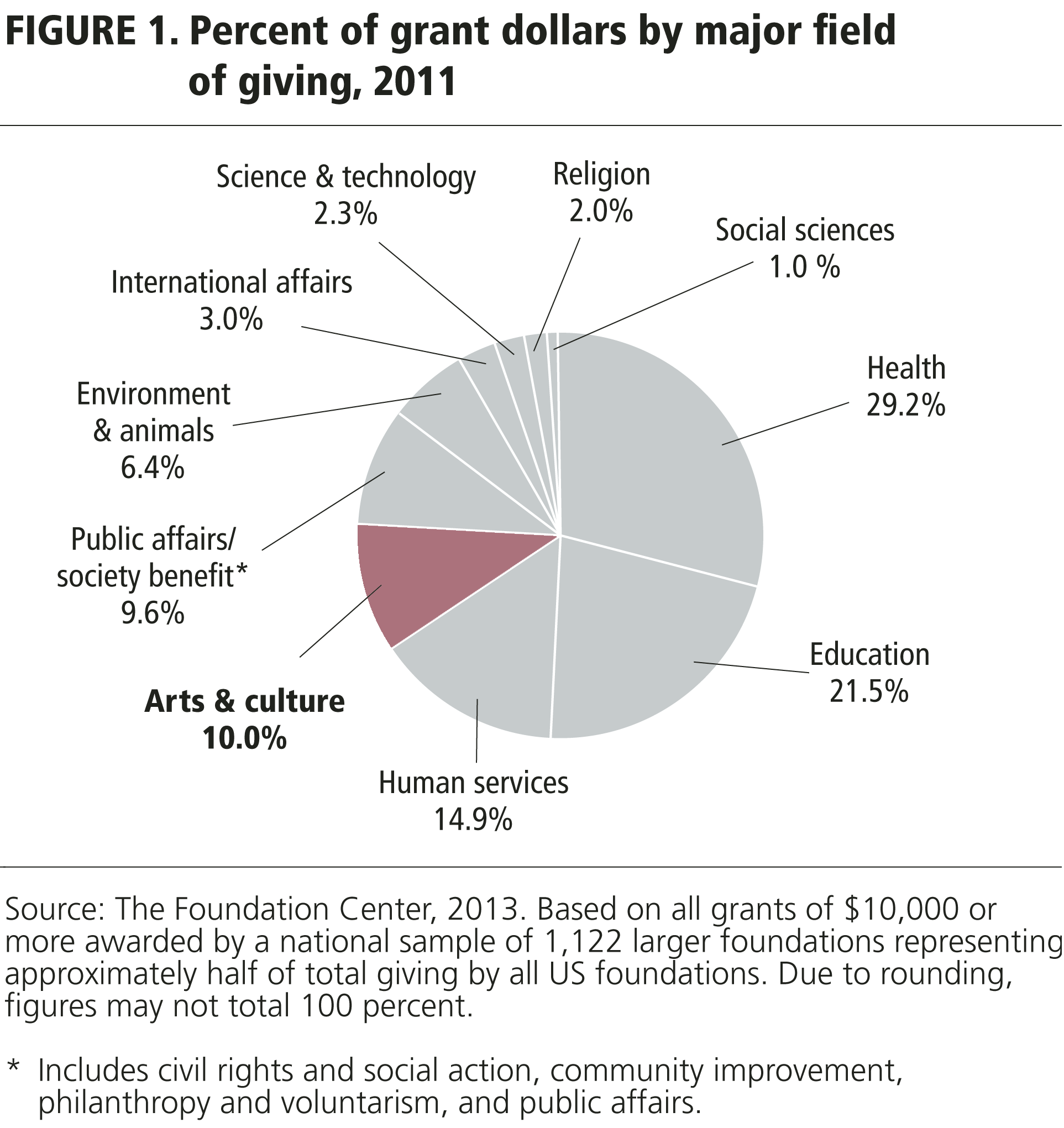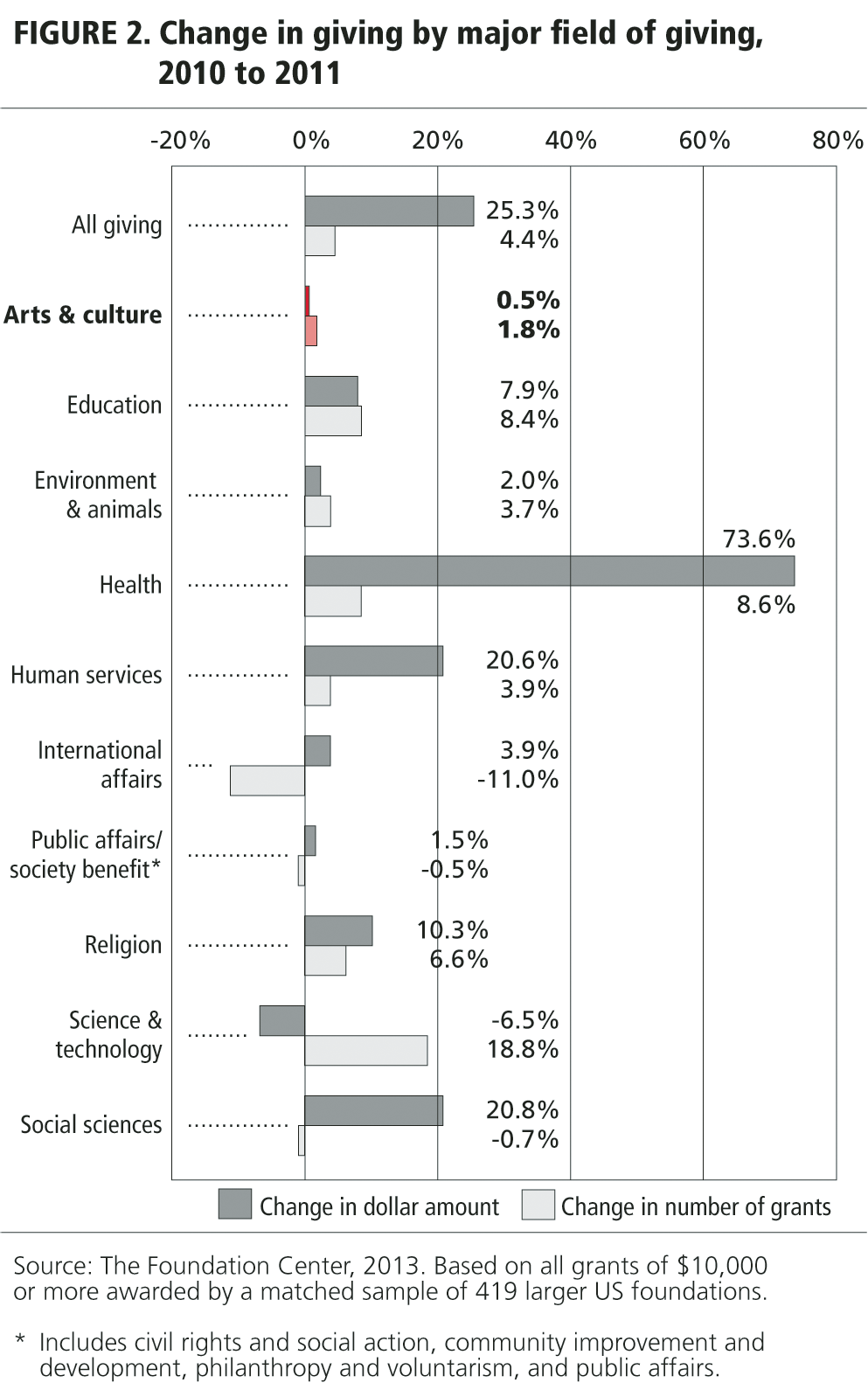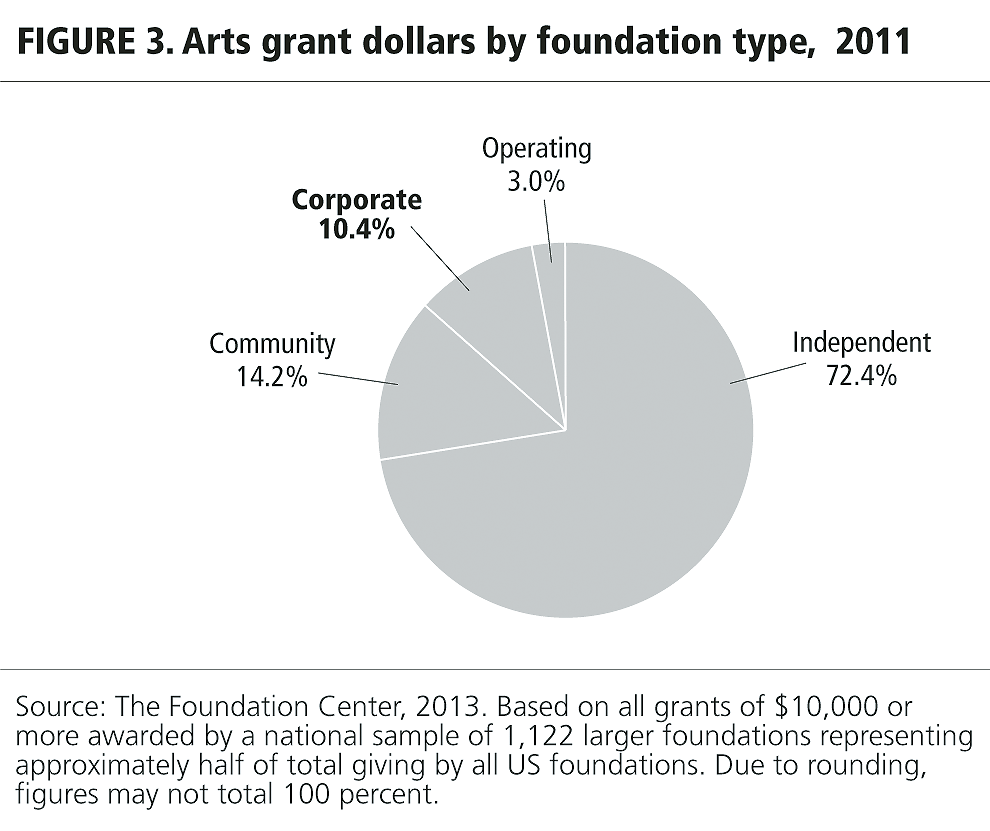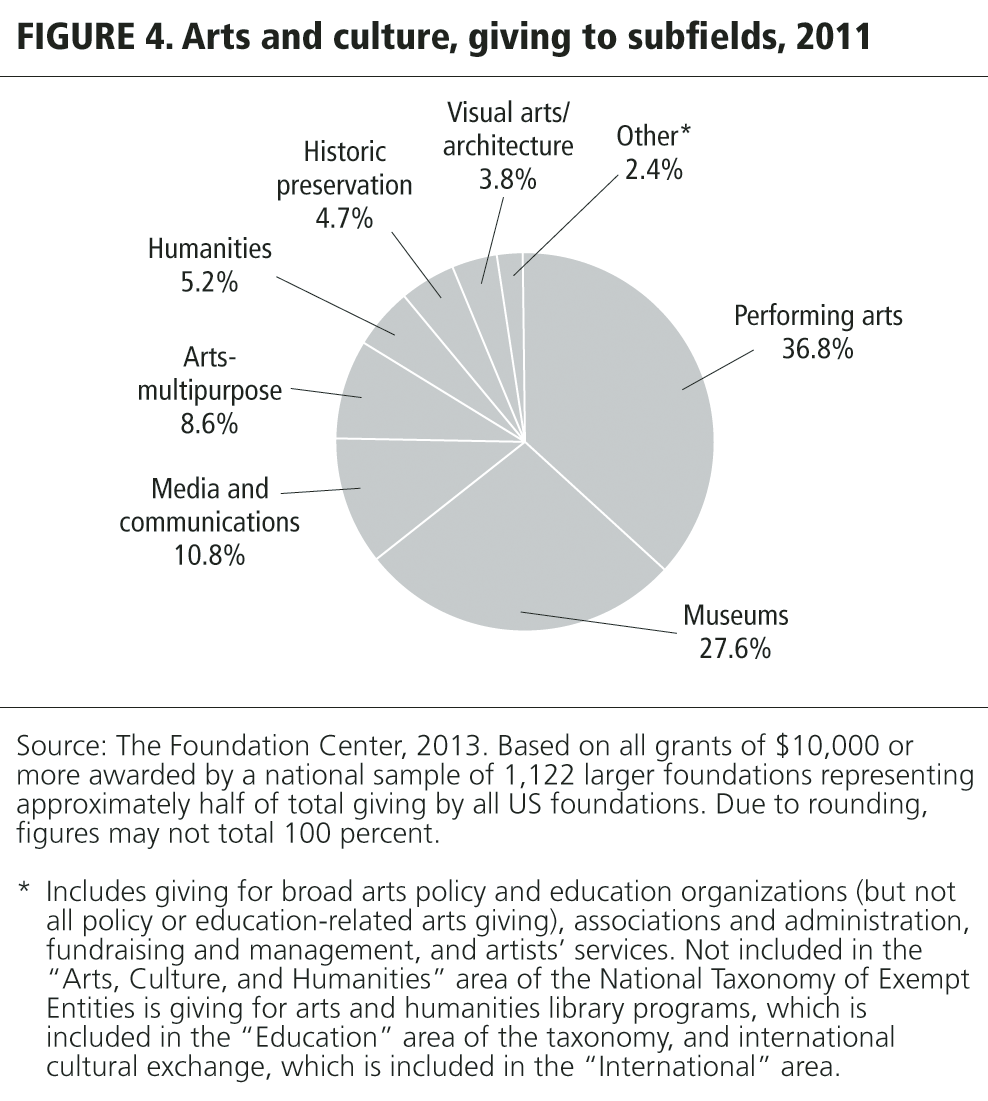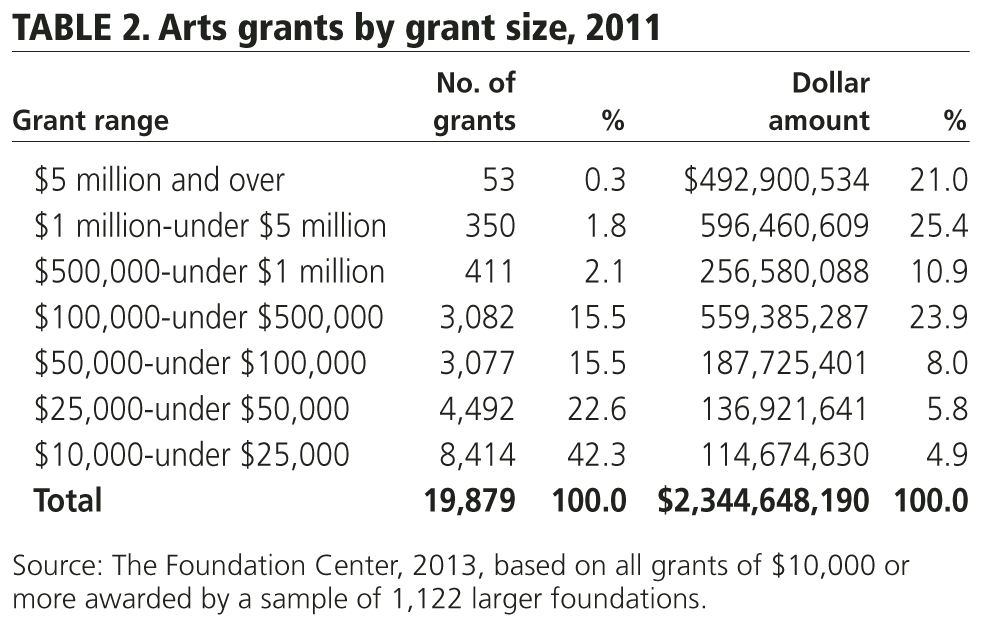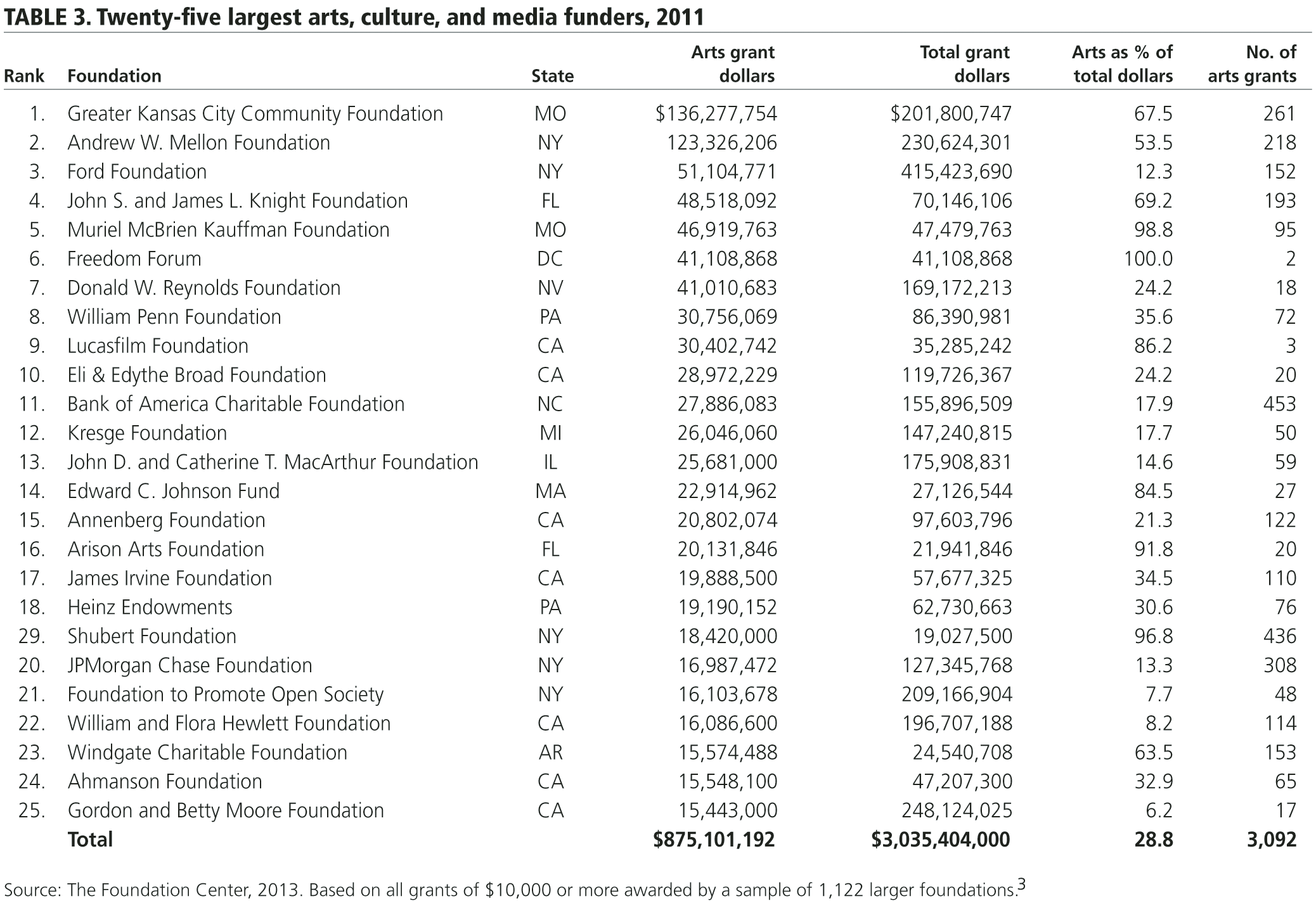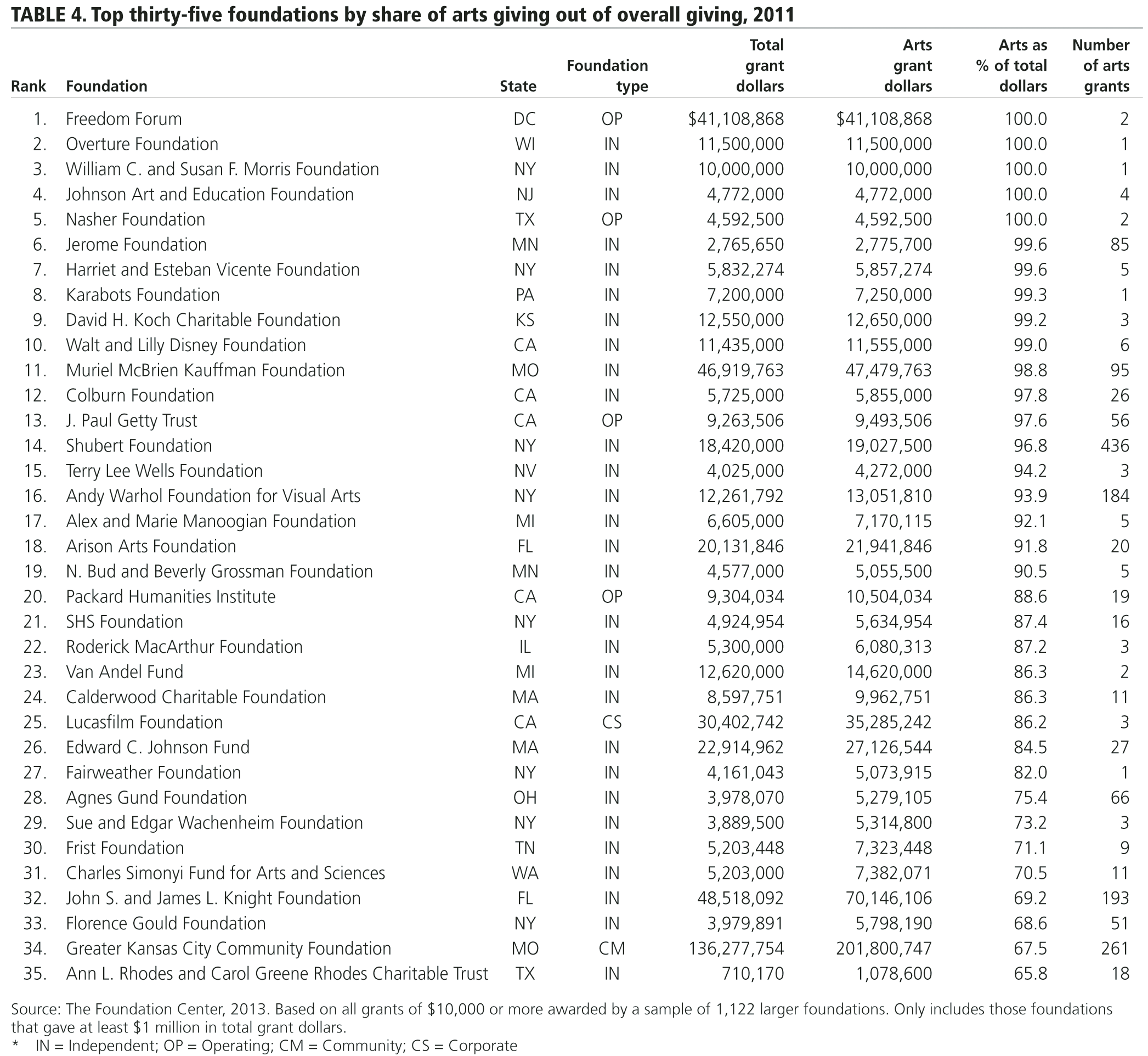Foundation Grants to Arts and Culture, 2011
A One-year Snapshot
Download:
![]() Arts Funding Snapshot: GIA's Annual Research on Support for Arts and Culture (6.8Mb)
Arts Funding Snapshot: GIA's Annual Research on Support for Arts and Culture (6.8Mb)
Giving by US foundations rose nearly 7 percent to a record $49 billion in 2011. After adjusting for inflation, however, foundation giving remained below the peak level reported in 2008. Despite continued economic volatility, many foundations appeared to have settled into a “new normal” of budget stability or modest annual increases in support combined with continued caution about making large, multiyear commitments.
In contrast to the single-digit increase in foundation giving overall, the following analysis shows that a matched set of the nation’s largest foundations raised their grant authorizations by a remarkable 25 percent overall between 2010 and 2011. Yet among these same foundations, arts funding was basically unchanged. It remains unclear whether there is potential for substantial growth in foundation funding for the arts over the next several years.
The Impact of Exceptional Giving for Crystal Bridges
The Foundation Center’s 2011 grants sample database, which serves as the basis for this analysis, included three grants awarded by the Walton Family Foundation to Arkansas-based Crystal Bridges Museum of American Art to establish an endowment and build the museum’s collection. While these types of foundation arts grants are common, the combined value of these specific awards was an unprecedented $1.2 billion. Including these awards in the total for 2011 arts funding results in arts and culture achieving its highest share of overall foundation giving recorded since the Foundation Center started tracking giving for the arts. However, given the disproportionate impact of these exceptional awards on long-term trends in foundation giving for the arts, the Foundation Center and Grantmakers in the Arts jointly determined to exclude them from this analysis. Nonetheless, all other arts-related giving by the Walton Family Foundation has been included.
Highlights
The Foundation Center offers these key findings from GIA’s twelfth snapshot of foundation giving to arts and culture. The definition of arts and culture used for this snapshot is based on the National Taxonomy of Exempt Entities and encompasses funding for the performing arts, museums, visual arts, multidisciplinary arts, media and communications, humanities, and historical preservation. Most important, the findings tell us about the changes in foundation giving for the arts between 2010 and 2011 by a matched set of 419 funders and the distribution of 2011 arts and culture giving by a larger sample of 1,122 foundations. 1 They are based on all arts grants of $10,000 or more reported to the Foundation Center by these sets of the largest US foundations, hereafter referred to as “the sample.” 2 The Center has conducted annual examinations of the giving patterns of the nation’s largest foundations for close to four decades.
Foundation funding for arts and culture remained nearly unchanged in 2011, based on a matched set of leading grantmakers. Arts funding increased a marginal 0.5 percent between 2010 and 2011, compared to a 25.3 percent increase in overall giving by the matched set of 419 foundations. Nine out of the 10 major funding areas posted growth in giving. Health reported the largest increase (up 73.6 percent), due primarily to a number of exceptionally large grants awarded by the Bill & Melinda Gates Foundation.
Arts funding represented a smaller share of total dollars included in the full 2011 grants sample. Among the 1,122 foundations included in the full grants sample for 2011, arts giving totaled $2.3 billion, or 10 percent of overall grant dollars. This share was down from 11.1 percent in 2010. By comparison, the share of number of arts grants — which is not affected by fluctuations in the size of grants — remained basically unchanged at 13.4 percent.
The size of the median arts grant remained unchanged. The median arts and culture grant size — $25,000 — did not change from 2010 to 2011, although the real value of the median grant decreased due to inflation. The unadjusted value was below the median amount for all foundation grants in the latest year and has not changed since 1993.
Large grants account for more than half of arts grant dollars. Large arts grants of $500,000 and more captured 57.3 percent of total grant dollars for the arts in the 2011 sample, up from 55 percent in 2010.
A larger share of arts grant dollars provided operating support than most other fields. In 2011, general operating support accounted for 32.2 percent of arts and culture grant dollars, surpassed only by public affairs/society benefit and international affairs. By comparison, just 19 percent of arts grant dollars provided operating support twenty years ago.
Top arts funders accounted for a smaller share of overall giving. The top 25 arts funders by giving amount provided 37.3 percent of total foundation arts dollars in 2011, down from 38.5 percent in 2010. The share of arts giving accounted for by the top funders remains well below the more than 50 percent shares recorded in the early 1980s.
Please note
It is important to keep in mind that the foundation grantmaking examined here represents only one source of arts financing. It does not examine arts support from earned income, governments, individual donors, or the business community. This analysis also looks only at foundation arts support for nonprofit organizations, and not for individual artists, commercial arts enterprises, or informal and unincorporated activities. In addition, the analysis of changes in giving between 2010 and 2011 is based on a matched subset of 419 funders, while statistics on the distribution of funding and actual dollar amounts and numbers of grants are based on the full set of 1,122 grantmakers included in the Foundation Center’s 2011 grants sample. 1
Specific Findings
Overall foundation dollars for the arts. The 1,122 larger foundations included in the Foundation Center’s full 2011 sample awarded 19,879 arts and culture grants totaling $2.3 billion, or 10 percent of overall grant dollars (figure 1) down from 11.1 percent in 2010. By comparison, the share of number of arts grants remained nearly unchanged at 13.4 percent. Among a matched subset of 419 foundations in the sample, giving for the arts remained basically unchanged. Between 2010 and 2011, it rose just 0.5 percent, compared to a 25.3 percent increase in grant dollars overall. Among the nine other major subject areas tracked by the Center, funding for all but one area grew during this period. Health, human services, the social sciences, and religion all registered double-digit increases in grant dollars, while science and technology posted a decline of 6.5 percent (figure 2).
The impact of exceptionally large grants. Every year and in all funding areas, a few very large grants can skew overall totals, creating distortions in long-term grantmaking trends. In 2011, 15 arts and culture grants provided at least $10 million, and instances where these grants had a notable impact on grantmaking patterns are identified throughout this analysis. 3 Despite the potential fluctuations caused by these exceptional grants, Foundation Center data in all fields have always included them, providing consistency over time. (In addition, the Foundation Center provides statistics based on share of number of grants, which are not skewed by exceptionally large grants.)
Corporate foundations represent an important source of support for arts and culture. While corporate foundations account for less than 4 percent of US private and community foundations, the larger corporate foundations included in the 2011 grants sample provided 10.4 percent of grant dollars for the arts (figure 3). Actual grant dollars totaled $244.1 million. By number, corporate foundations allocated 3,707 grants, or 19 percent of the overall number of arts grants in 2011.
Grants by arts subfield
Funding for the performing arts accounted for over one-third (36.8 percent) of all foundation arts dollars in 2011 (figure 4), surpassing the share reported for museums (27.6 percent). From the start of the 1980s until 1997, the performing arts consistently received more foundation support than museums. However, museums have surpassed the performing arts by share in several recent years (1998, 1999, 2001, 2004, 2005, 2008, and 2009). More study would be needed to adequately understand the underlying reasons for the shifts in share between these two fields of activity, for example, the entry onto the scene of new and large arts funders, extraordinarily large grants, the contribution of valuable art collections, and new capital projects at museums.
Giving to performing arts. In 2011, performing arts grant dollars increased 6.5 percent among the matched subset of 419 funders, while the number of grants rose 4.2 percent. A total of 8,143 grants were awarded for the performing arts by the overall set of 1,122 foundations — close to double the number reported for museums. In general, the average performing arts grant tends to be smaller in size than the average museum grant. The largest share of giving to the performing arts supported the performing arts generally (including performing arts centers and education), and music (including symphony orchestras and opera), followed by dance and theater. The largest performing arts grant in the latest sample was a $28.3 million award from the Donald W. Reynolds Foundation to the Nevada-based Smith Center for the Performing Arts to promote cultural, artistic, and educational opportunities for the Las Vegas community. Included within the performing arts is support for performing arts education, which totaled $43.4 million in 2011. (See “Giving to multidisciplinary arts” below for a figure on foundation grant dollars supporting other types of arts education.)
Giving to museums. In 2011, museums benefited from 4,140 grants totaling $646 million awarded by the 1,122 foundations included in the full grants sample. Among museum types, nearly half of funding (47.2 percent) supported art museums. Among the matched subset of 419 foundations, grant dollars allocated to museums declined 20.2 percent between 2010 and 2011, while the number of grants awarded decreased 7.3 percent.
Giving to media and communications. Support for media and communications 4 represented 10.8 percent of arts funding in 2011, up from 8.9 percent in 2010. This subfield benefited from 1,950 grants totaling $253 million awarded by the 1,122 foundations included in the full grants sample. Among the matched subset of funders, grant dollars for media and communications rose 24 percent in the latest year.
Giving to multidisciplinary arts. The share of arts giving for multidisciplinary arts 5 declined to 8.6 percent in 2011. Nearly 2,400 grants totaling $201.7 million were awarded for multidisciplinary arts by the overall set of 1,122 foundations. Among the matched subset of foundations, grant dollars awarded for multidisciplinary arts were up 12.2 percent from 2010. Among the various subcategories of multidisciplinary arts, arts education (excluding performing arts education) totaled $50.2 million in the latest year.
Giving to the humanities. Funding for the humanities 6 accounted for 5.2 percent of arts grant dollars in 2011, virtu- ally unchanged from 5 percent in 2010. Overall dollars totaled $122 million. Among the matched subset of funders, grant dollars for the humanities rose over 16 percent. Included within the humanities is funding for art history, history and archaeology, classical and foreign languages, linguistics, literature, philosophy, and theology.
Giving to historic preservation. Support for historic preservation declined 34.3 percent between 2010 and 2011 among the matched subset of funders, although the number of grants held steady. Within the full set of 1,122 grantmakers, historic preservation benefited from 1,157 grants totaling $11.4 million in 2011.
Giving to the visual arts. Among the matched subset of 419 foundations, grant dollars for the visual arts and architecture increased 4.8 percent between 2010 and 2011, and the number of grants for the field climbed 20.7 percent. Within the full set of grantmakers, the visual arts and architecture benefited from $89.5 million in 2011, up from $72.8 million in 2010.
Grants by types of support
An important caveat to report on the allocation of foundation dollars by specific types of support is that, for roughly 21 percent of arts grant dollars in the 2011 Foundation Center sample, the type of support could not be identified. This means that modest differences in percentages — that is, variations under 10 percent — may not be reliable. (The grant records available to the Foundation Center often lack the information necessary to identify the type of support. For example, it is often the case that the only source of data for this sample on foundations’ grants is the 990-PF tax return, and this tends to be less complete than other forms of grant reporting.)
The arts compared to other foundation fields of giving. The three largest categories of support tracked by the Foundation Center are program support, general operating support, and capital support. Of these, special programs and projects typically receive the largest share of arts and culture grant dollars and grants. In fact, the same is true in most of the major fields, such as health and education, where program support consistently accounts for the largest share of funding.
General operating support accounted for the second largest share of arts grant dollars in 2011. The shares of grant dollars and number of grants allocated for this type of support in 2011 were higher for arts and culture (32.2 percent and 37 percent, respectively) than for all other fields, with the exception of public affairs/society benefit and international affairs. Moreover, the portion of grant dollars allocated to this type of support has risen markedly over the past two decades; operating support represented only 13 percent of arts funding in 1989.
Capital support captured roughly 23 percent of the share of arts grant dollars in 2011, up from 21.8 percent in 2010. The share of grant dollars allocated for this type of support was higher for arts and culture than for all but one field (science and technology). Grants for capital support are larger on average than awards for program and general operating support, and exceptionally large capital grants can have a pronounced effect on the distribution of funding by type of support. In fact, arts dollars allocated to capital support have fluctuated more than arts dollars to the other two primary categories of support: in 1986 the share allocated to capital was about 44 percent; in 1993 it was about 30 percent; and in 1999 it was about 41 percent. (In general, the share of capital support is highest in periods of strong foundation asset growth.)
Arts grants by specific types of support. Table 1 provides a breakdown of more specific types of support within the larger support categories and lists both the specific dollar value and number of grants made in each type. As with all data in the Snapshot, it is important to keep in mind that this table includes only grants of $10,000 or more awarded to organizations by a sample of 1,122 larger foundations. It is also important to note that approximately 21 percent of the arts grant dollars in this sample were not specified for a type of support.
Grants by grant size
Median grant size. The median or “typical” grant amount 7 for arts and culture in 2011 was $25,000, which was below the median amount for all foundation grants ($28,464). This amount has remained unchanged since 1993. If this amount were adjusted for inflation, however, it would have lost value in real dollars. More study would be required to determine whether the unchanged median means that foundation arts grants simply are not keeping pace with inflation, or whether, in combination with the increased number of grants, it means that foundations are choosing to distribute funds more broadly to a larger number of recipients.
Small and mid-sized grants. Roughly two-thirds (64.9 percent) of all arts grants in the 2011 sample were for amounts between $10,000 and $49,999 (table 2), just under the 2010 share. The share of mid-sized arts grants ($50,000 to $499,999) also remained fairly consistent at just over 30 percent.
Large grants. The share of larger arts grants ($500,000 and over) increased to 4.2 percent of the total number of arts grants in 2011, compared to 3.4 percent in 2010. Their share of total grant dollars was also higher at 57.3 percent, compared to 54.8 percent in 2010. Overall, foundations in the sample made 112 arts grants of at least $2.5 million in 2011, up from 93 in 2010.
In addition to the $28.3 million grant from the Donald W. Reynolds Foundation to the Smith Center for the Performing Arts (noted earlier), examples of other especially large grants in the 2011 sample included the Muriel McBrien Kauffman Foundation’s two $15 million grants for the Kauffman Center for the Performing Arts; the Amon G. Carter Foundation’s $8.7 million operating grant for the Amon Carter Museum of Western Art; and the William Penn Foundation’s $7 million grant to the Philadelphia Orchestra Association.
The 25 largest arts funders. The top 25 arts funders by giving amount provided 37.3 percent of the total arts dollars in the Foundation Center’s 2011 sample (table 3), down from 38.5 percent in 2010. Overall, the share of giving accounted for by the top 25 arts funders has fluctuated between 33 and 39 percent since the end of the 1990s. By comparison, in the early 1980s, the top 25 arts funders accounted for more than half of the grant dollars in the sample. This suggests that the base of large arts funders has widened since that time, making arts funding less concentrated among a small number of foundations.
Top foundations by share of arts giving out of overall giving. Of the foundations that committed large percentages of their grant dollars to arts and culture, many are the smaller foundations in the sample (table 4). Among the top 100 foundations ranked by share of arts giving out of total giving, over half of foundations (54) gave less than $5 million in total arts grant dollars in 2011.
Notes
- Over time, the sample size has changed, which could also distort year-to-year fluctuations in grant dollars and grants targeting specific activities or populations. To account for these potential distortions year-to-year, the Foundation Center has analyzed changes in giving based on a matched set of funders while other analyses are based on the larger pool of foundations (see footnote 2 for more details on the larger sample). Arts giving by the 419 matched set of funders in 2011 totaled $1.1 billion while total giving for the arts by the larger sample of 1,122 foundations totaled $2.3 billion for that year.
- Source of the data. The original research upon which this report is based was conducted by the Foundation Center. Specifically, the source for data was the Foundation Center’s Grants Stats posted on the Gain Knowledge section of the Center’s website and the grants sample database. The data for “circa 2011” include all grants of $10,000 or more awarded by 1,122 of the largest US foundations and reported to the Foundation Center between August 2011 and September 2012, excluding three grants made by the Walton Family Foundation to the Crystal Bridges Museum of American Art totaling $1.2 billion. Approximately three-fifths of grant dollars represent 2011 grant authorizations or payments, with the balance reflecting 2010 authorizations or payments. (The incorporation of “older” data reflects delays in the availability of timely grants information.) The grants sample typically represents about half of total grant dollars awarded annually by the more than 80,000 active US independent, corporate, and community foundations that the Foundation Center tracks. (The sample also captures roughly half of all foundation giving for arts and culture.) For community foundations, only discretionary and donor-advised grants were included. Grants to individuals were not included.
- This figure excludes the three Walton Family Foundation grants to Crystal Bridges Museum of American Art totaling $1.2 billion.
- Includes support for the production and dissemination of one or more media forms, including film/video, television, radio, and print publishing; and support for journalism and communications centers.
- Includes support for multidisciplinary centers, ethnic/folk arts, arts education, and arts councils. For a detailed analysis of foundation funding for arts education, see L. Renz and J. Atienza, Foundation Funding for Arts Education (New York: Foundation Center, 2005).
- Includes support for archaeology, art history, modern and classical languages, philosophy, ethics, theology, and comparative religion.
- The median — meaning that half of the grants are above and half are below the amount — is generally acknowledged to be a more representative measure of the typical grant than the mean or “average,” because the median is not influenced by extreme high or low amounts.

